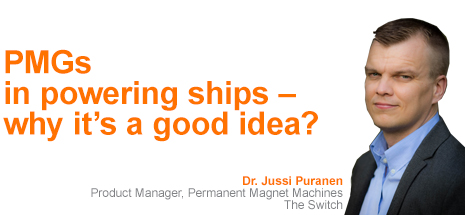Permanent magnet (PM) generators have been utilized with great success and satisfaction in numerous fields to date, including distributed power generation, elevators and hybrid cars. However, in the maritime industry, the shift from traditional technology in power generation has been slower due to skepticism within the industry. Read on to find out what immense benefits PM generators bring to ships, compared to traditional technologies.
Development of electric power generation in ships
Electric power generation in ships has usually been conducted by separate auxiliary gensets or shaft generators connected to the main engine, either directly or through a gearbox. The auxiliary genset’s positive side is that it doesn’t require power electronics for frequency conversion when driven in constant-speed mode. However, the auxiliary gensets have higher specific fuel-oil consumption compared to the main engine, and they can’t run with cheaper heavy fuel oil (HFO) without additional equipment. Additionally, they need more maintenance.
Shaft generators, which have typically been electrically excited synchronous generators (EESG), have been one option. Here, the shaft generator system consists of the EESG, which is mechanically connected to the main shaft and electrically connected to the ship’s grid – either through a frequency converter or directly, in which case only fixed speed is possible. The EESG system is rather complex, requiring additional equipment such as a brushless exciter and an automatic voltage regulator (AVR). Most importantly, it has lower efficiency due to losses in the rotor winding. They are also physically large and have high rotating inertia.
PM shaft generator system – how does it help?
One of the most promising solutions is to replace the direct-driven electrically excited generator with a permanent magnet generator (PMG). The PM shaft generator provides three main benefits over the traditional technology.
The PMG has 2–3% higher efficiency through the entire operating range, reducing fuel oil consumption and emissions. This is explained by the fact that the PMG does not need additional energy for the magnetization.
Secondly, the PMG is much simpler in terms of mechanical construction, resulting in greater reliability. It requires no additional equipment, which would need maintenance and pose the risk of failure.
The third benefit is extremely low inertia and weight. This is related to the simple rotor construction. The EESG rotor is constructed of a solid-steel rotor with massive field poles and windings attached. In comparison, the PMG rotor is in fact a hollow steel cylinder with magnets fixed on its surface. These features have direct positive effects on the dynamic performance of the whole shaft line, including torsional vibrations and design flexibility for the ship.
To find out more on the technology behind these benefits, please read a more detailed explanation of PM machines in direct-driven shaft generator systems.
PMGs: Creating new savings for the maritime industry
Frequency converters boost efficiency
Coupling a PM shaft generator with a frequency converter from The Switch seamlessly gives the maximum amount of freedom in optimizing the engine and propeller efficiencies. During slow steaming, a frequency converter allows lowering the propeller speed and therefore significantly saving fuel. This will also help in meeting the tightening emission regulations (e.g. IMO Tier III).
The Switch keeps setting pace
The Switch has designed and manufactured over 20 direct-drive shaft generators for various speed and power ratings. Acceptance from certification agencies has been positive, and several machines are already in operation. Since power demands from customers keep increasing, The Switch has designed new shaft generator frame sizes which can go beyond 10 MW in power. The Switch will also set up a world-class testing facility for electrical drive trains in Lappeenranta, with a capacity of 15 MW. Read more on our customer references.
About the author
Dr. Jussi Puranen currently works as Product Manager for Permanent Magnet Machines at The Switch, Finland. His specialties are electromagnetic design and R&D of permanent magnet generators and motors. Puranen holds M.Sc. and D.Sc. (Technology) degrees in Electrical Engineering from the Lappeenranta University of Technology (LUT), Finland.
